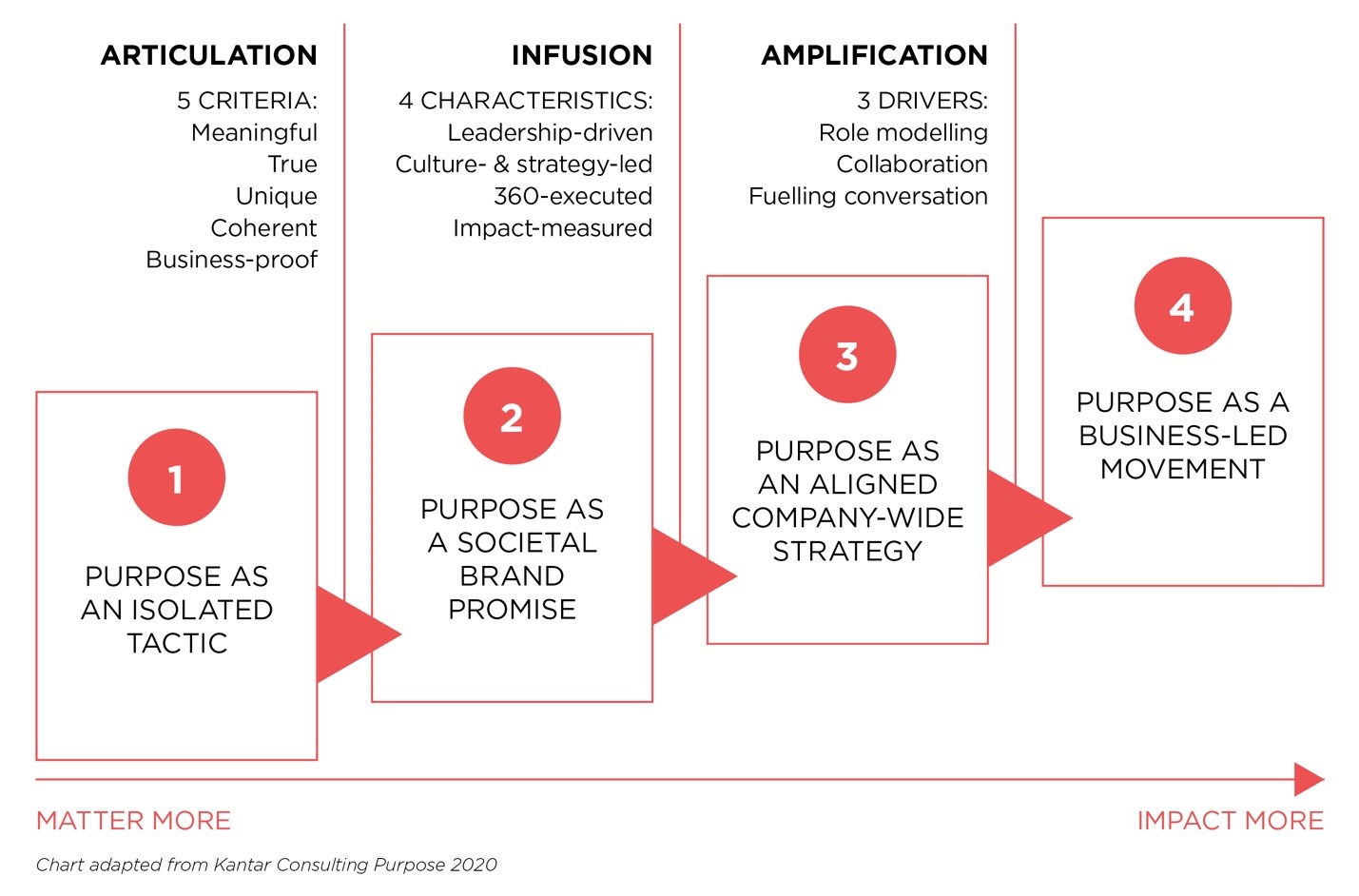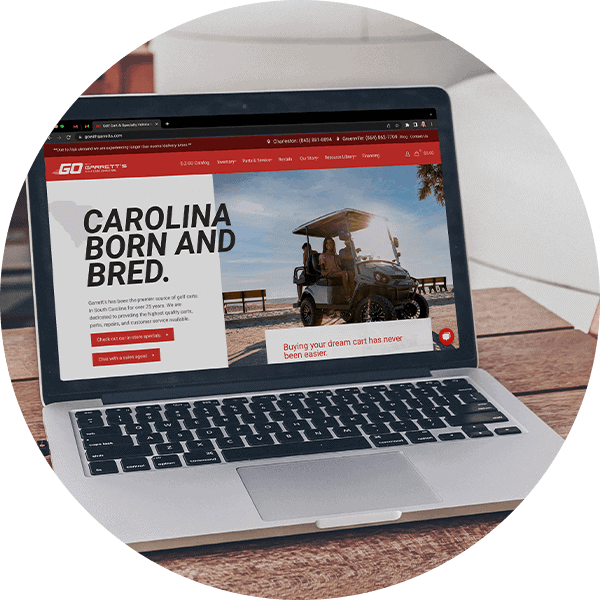
Getting Chosen for a Featured Snippet in Google SERPs
March 6, 2020
Build a Better Brand: Meaningful Brand Marketing
April 24, 2020What’s your brand purpose? It’s a good question – and often confusing one. Many people think that brand development is simply a company’s logo, colors, or tagline, but a brand is so much more. Your brand is what exists in the minds and hearts of your consumers. Jeff Bezos said, “Your brand is what other people say about you when you’re not in the room.” In this age of hyperconnectivity, the consumer is in the room 24/7, not only listening but joining in on the conversation and inviting their friends to join, too.
Chances are you’re not the only one selling your particular product. Consumers often have multiple choices when buying a product and the freedom to be picky with how they spend their time and money. They will give their business to the company or organization that aligns with their worldview and supports social issues that are important to them. According to a study by Kantar Consulting, 76% of marketers believe their organization has a defined purpose; however, only 10% of those marketers believe that this purpose includes a substantial societal commitment.
In 2022, what is brand development without a brand purpose? Your brand is, first and foremost, your company’s purpose, and your company’s values, mission, and vision come out of that purpose. Having a brand purpose doesn’t just make you memorable; it makes you more authentic and authoritative among your competitors. So, if your company doesn’t have a brand purpose – or it isn’t well defined – consumers will look past you.
What is Brand Purpose?
Every successful brand has a compelling purpose behind it. Simply put, your brand purpose defines how your company intends to function. The role of a stated brand purpose is to unite leadership, employees, clients, and the public in general, in pursuit of that intention. Essentially, it’s your company’s why statement, and knowing why your company exists provides the foundation on which you build everything else. Your purpose lets consumers know you’re thinking beyond your bottom line. You can use your brand purpose to define your company’s values, mission, and vision. Your values are the ethics and behaviors you’ll use to sell your product or service. Your mission outlines what you need to do to reach your goals. Your vision is where you want your company to be in the future.
One of my favorite illustrations of good brand purpose is from President John F. Kennedy. He told a story about when he was touring a NASA facility and approached a janitor holding a broom. When the president asked the janitor what he was doing, the man replied, “Well, Mr. President, I’m helping put a man on the moon.” This story powerfully demonstrates how NASA’s purpose had spread into every aspect of the organization and was driving the organization’s values, mission, and vision.
A compelling brand purpose relates directly to the product or service you offer. You want to build a brand platform where every interaction is a shared experience with the consumer. Two brands that do this well are Patagonia and Dove.
Patagonia is an outdoor clothing company created by rock climbers and surfers. They started infusing purpose into their brand as early as the 1970s when their top executives would attend local government meetings to promote climate change activism. Now, that same level of activism is written into their company’s core values – “Use business to protect nature.” They’ve even gone so far as to instate a self-imposed 1% “Earth tax” to provide support to environmental-based nonprofits. When consumers buy a Patagonia brand jacket or pair of shoes, they know that part of their purchase directly supports environmental activism.
Similarly, Dove developed their brand Purpose in the mid-2000s after recognizing the direct correlation between women’s self-esteem and beauty products. Dove’s purpose is “to redefine beauty standards and help all women experience beauty and body image positively.” Dove carries this purpose through its values, mission, and vision. It has used this purpose as the basis for all of its campaigns since 2004.
We are living in the era of brand Purpose. Fostering a Purpose that resonates with your consumers reinforces the relationship at the heart of successful brand strategies.
How to define your Brand Purpose
To build your brand purpose, start by drafting a concise purpose statement. Your statement should be short, memorable, strategic, and intentional, and answer your why. Begin with these four questions:
- Why does your company exist?
- How are you different from your competitors?
- Why do your customers/clients trust you?
- What is your positive impact on other people’s lives and the world in which they live?
Don’t be afraid to ask for answers to these questions from multiple recipients – leadership, middle-management, entry-level employees, and even clients/customers. It’s good to get input from different points of view and see where your company perception (or misperception) is aligned. From this input, define your purpose as an isolated statement. Limit this statement to one sentence that lays out a single tactic. Some examples of viable brand statements include:
- JetBlue: To inspire humanity – both in the air and on the ground.
- Tesla: To accelerate the world’s transition to sustainable energy.
- Life is Good: To spread the power of optimism.
- Starbucks: To inspire and nurture the human spirit – one person, one cup, and one neighborhood at a time.
- Dove: To redefine beauty standards and help all women experience beauty and body image positively.
- Waypost: To model the motives and actions of a trustworthy marketer.
Once you have a concise written purpose statement, you can develop your purpose-driven brand. Kantar Consulting’s Purpose 2020 Study created a three-phase blueprint for turning your isolated brand statement into an actual business-led movement: Articulation, Infusion, and Amplification.

Phase One: Articulation
Take your isolated brand statement and put it to the test! The Articulation Phase defines what you stand for and the role you want to play. Test your new brand statement against these five characteristics to establish whether or not your statement holds up as a viable brand purpose:
- Is your statement meaningful (through societal tension or localization)?
- Is your statement true (to the character of your company)?
- Is your statement unique (throughout your industry)?
- Is your statement coherent (so that it ties back to your product or service)?
- Is your statement business-proof (for long-term growth and impact)?
If you answered YES to all of these questions, congratulations! Your statement is ready to become a full-blown societal brand purpose. You’re ready to begin infusing your brand purpose into a healthy company culture.
Phase Two: Infusion
In the Infusion Phase, your purpose statement becomes the foundation for every aspect of your business. Your website, corporate identity, content tone, and client interactions should all refer to your purpose statement. Infusion is the key to ensuring your brand has an impact. Your purpose should be:
- Leadership-driven. Your company’s leadership should prioritize brand purpose and actively demonstrate this purpose in their lives and work.
- Culture-led. Living out the brand purpose should be a priority in the workplace.
- 360-executed. Your brand purpose must have substance.
- Impact-measured. Set measurable goals that demonstrate the impact of your brand purpose and learn from the results.
Infusion is the stage where you use your purpose statement to form and define your company’s values, mission, and vision. Once you complete the Infusion process, your brand purpose will become a company-wide brand marketing strategy.
Phase Three: Amplification
Amplification is about taking your purpose beyond your company. It is the phase where your brand purpose statement goes from being a tactic to being a movement. There are three critical drivers for Amplification:
- Be inspirational. Be a role model in your industry.
- Be collaborative. Work with companies who share your values and mission.
- Fuel the conversation. Don’t be afraid to take a stand.
Ultimately, brands that do well in Amplification will create a movement that endures.
Yeah, but does all this matter?
Is it beneficial to be recognized as a purpose-led organization that shapes its internal and external environment? The short answer is yes. Here are a few examples of amplified brand purpose in action:
Near the end of 2011, Patagonia ran a full-page Black Friday ad that read in large block letters, “DON’T BUY THIS JACKET.” The ad explained the environmental cost of making one of the company’s best-selling fleece jackets and asked customers to consider buying a second-hand Patagonia product instead. Despite this (or perhaps because of this), Patagonia saw its revenue grow almost 30% in 2012, followed by another 6% growth in 2013.
In 2014, in an attempt to be a role model in their industry, CVS stopped selling cigarettes at all its stores. According to their executive vice president, the ban cost CVS $2 billion in revenue. Still, the longer-term benefits have been worth it. Hiring has become much easier because more Millennial workers rally behind their cause. CVS has also saved money in human resources and insurance. These business partners recognize that hiring employees who don’t smoke is less expensive. Despite the loss of cigarette revenue, by the end of 2014, CVS posted an almost 10% increase in annual revenue, and their operating profit went up by more than 4%. In 2016 – just two years after making a significant brand purpose shift – CVS’s stock price was up 66%.
In 2018 Unilever announced that its 26 sustainable living brands (the brands to which Unilever gave defined societal brand purpose statements, like Dove) grew 46% faster than the rest of its businesses.
Takeaways
Whether you like it or not, we’re living in the era of brand Purpose. You must be able to answer your company’s why, and the consumer needs to be aware of it. Find out what your organization is passionate about. Identify ways to draw parallels back to your product or service. Make your brand purpose the cornerstone of your culture. Be a role model for this purpose. Give your brand a higher calling. And get people excited about it!
Your company’s purpose isn’t to save the world, but modern consumers expect you to prioritize social responsibility. Brands that endeavor to do good are destined to do better. Doing good starts with identifying and rallying behind your brand’s higher calling – your brand purpose.
If you’re overwhelmed by the idea of brand purpose or don’t know where to start, give Waypost a call or contact us online today.









